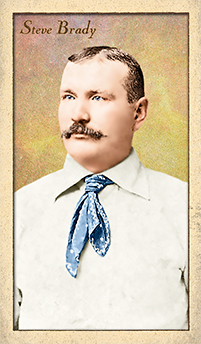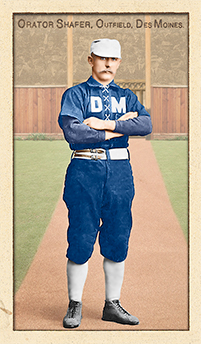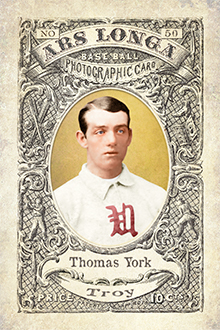
- Series: 1880s: Spotted Ties
- City: New York
- Team: Metropolitans
- League: American Association
Stephen A. Brady (1851-1917) was born in Worcester, MA and began playing professional ball in New England in the early days of the sport's arrival on the national scene. Brady started out with the Hartford Dark Blues of the pre-modern majors - the National Association of Professional Base Ball Players. The NAPBBP had become the first openly pro league in 1871 and Steve joined the fraternity the same year the Hartfords did, 1874.
Seven eastern seaboard clubs plus Chicago made up the circuit that year. Owned and organized by Morgan Bulkeley and anchored by the likes of Cherokee Fisher, Bob Addy, Orator Shafer and Lip Pike, Hartford’s Dark Blues disappointed and dwelt near the cellar in 1874, finishing with a 16-37 record as the Boston Red Stockings continued their dominance. Rookie Brady did well in a utility role however, contributing a .314 average in 27 games to an otherwise dismal season.
Brady would play only one game for the Dark Blues in 1875 before being shipped off to the Washington Nationals. The move was likely regrettable for him professionally. The Nationals would go 5-23 and bankrupt while his former Dark Blues dominated at 54-28 on the strength of contributions from a few newly acquired superstars. Tommy Bond and Candy Cummings won those 54 games with a combined ERA of 1.56 while the team, including recently acquired sluggers Black Jack Burdock and Tom York, flourished under the leadership and defensive wizardry of new player/manager Bob “Death to Flying Things” Ferguson.
Meanwhile, Brady’s performance in Washington mirrored his team’s: he floundered with a .143 batting average for a club that produced a .179 winning percentage. The minors soon beckoned and Steve played for NY and MA clubs, including the Metropolitans whom he joined for the 1881 season in the Eastern Championship Association. The team moved to the League Alliance and, in '83, ascended to the American Association, returning Brady to the majors through 1886. Moved to the outfield in '84, Steve's offensive production stabilized and he batted .264 over his tenure in NY. By 1887 Brady's old Hartford team was now in the Eastern League when he rejoined them for a very successful season, hitting .350.
- Per Wikipedia: Brady’s 1875 Washington Nationals "went out of business in St. Louis, Missouri, after playing the local Red Stockings on July 3 and July 4. Next day the players announced by telegraph that a club official had absconded with the funds but (Ryczek 1992: 194) concludes that "the tale had been planted by the players in an effort to find enough good samaritans to foot the bill for the trip home." The club probably failed by "unappealing play" and consequent receipts too small to support travel. On the final trip, they lost two in Philadelphia and five of six in St. Louis. The final game was a 12-5 victory but the two local teams outscored Washington 42-5 in the first five games, which must have been repelling."
Auction History
Cartophilia
Old Judge Pose: 39-1

- Series: 1880s: Spotted Ties
- City: New York
- Team: Metropolitans
- League: American Association
James Augustus Donahue (1862-1935) debuted with the New York Metropolitans on April 19, 1886 where he would play outfield and catch through the following season. He played his entire major league career with American Association clubs, moving to the Kansas City Cowboys for two years and finishing with the Columbus Solons in 1891 after a one year absence from the upper echelons of the game. His sophomore season proved his best. Jim was back-up to Bill Holbert and batted .282. New York sent Donahue to the Brooklyn Bridegrooms following the '87 season but Brooklyn dealt him to KC that winter. Donahue's rookie year had seen him labor for a struggling Metropolitan squad who finished in seventh place, 38 games behind the St. Louis Browns who bested them 16 times in 20 contests. As noted above, the next year proved much more satisfying for Jim, and, when he moved west, his playing time increased. He was the starting receiver for the Cowboys, appearing in 88 games. That '88 season found Donahue embroiled in a controversy. Dragooned into the role of substitute umpire on two occasions, Donahue was accused by Brooklyn's Adonis Terry of heeding an order from KC manager Sam Barkley to call a Bridegroom runner out in the ninth inning of a 5-4 match. Brooklyn left the field in protest and suffered a forfeit.
- Jim's career line included a .234 BA, with 2 HRs and 33 steals
Auction History
Cartophilia
Old Judge Pose: 128-1

- Series: Beginnings: 1880's
- City: Des Moines
- Team: Prohibitionists
- League: Western Association
George W. Shafer (1851-1922) still ranks tenth all-time in outfield assists. The right fielder extraordinaire also continues to hold the single-season record with 50 runners cut down in 1879. Known for jawing at himself out in right if he didn’t have an umpire nearby to harangue, “Orator” was far from all talk. He had great seasons at bat and perennially ranked among the best outfielders of his day. Shafer began with the Hartford Dark Blues of the NA in 1874. Like many in the early decades of baseball, he moved around a lot. By the time he returned for a second stint with the Athletics in 1890, he had played for ten teams in 14 years. He had a great year at bat for the Indianapolis Blues in ‘78 where his .338 average was sixth in the NL. Four times he led the league in outfield assists. Orator was a key member of Cap Anson’s White Stockings, batting .304 the year he set the assist record. From 1887-89 the volatile Shafer made his living with minor league squads where he hit well and also drew a suspension for decking an umpire.
- Shafer’s final ML season was back in Philly where he was joined by younger brother (Zachary) Taylor at 2nd base
- Orator had an even 1,000 hits, good for a lifetime .282 average
- Shafer’s uniform color on this card was changed in May, 2017 from black to blue to reflect recent reliable research by Craig Brown & friends at Threads of Our Game. Two cards had been previously released featuring a black uniform.

- Series: Beginnings: 1880's
- City: Minneapolis
- Team: Millers
- League: Western Association
Milton Douglas West (1860-1929) was another in a long line of players who could excel in minor league play but flounder on the big stage. Buck often hit over .300 during his long tenure in professional baseball. He starred in many of the higher circuits including the Northwestern and Tri-State Leagues; and the Western and Southern Associations from 1883-1895. His chances in the majors came twice, first with the Cincinnati Red Stockings of the American Association in 1884 and finally with the Cleveland Spiders of the National League in 1890. Significantly, Buck’s call-ups came when baseball was sifting out its league organizations. The years he played at the top were years a rival third league made overtures to compete. The talent pool was tested and players such as West got rare opportunities to show their mettle. The sturdy outfielder was a big man for his day at 5’10” and 200 lbs, yet he swatted only three home runs in MLB. But one of those was memorable, establishing West as the first in the big leagues to homer in his final at-bat, September 18, 1890 at League Park.
- Buck’s offensive output for his two seasons: 282 ABs, .245 average with 40 RBI
- He reached his pinnacle at the plate with the Syracuse Stars in 1891 hitting .339 and leading the Eastern Association

- Series: Pioneer Portraits I: 1850-1874
- City: Troy
- Team: Haymakers
- League: National Association (NABBP)
Thomas Jefferson York (1850-1936) began playing amateur ball on a big stage with the National Association of Base Ball Players’ Powhatans of Brooklyn in 1869. He joined the Troy Haymakers in 1871 as their left fielder in the now openly professional NAPBBP. Tom stayed in the nascent pro circuit with the Baltimore Canaries and Philadelphia White Stockings through the 1874 season. The following year saw York in Hartford with the Blues and migrated with the club to the new National League in 1876. The team became the Hartfords of Brooklyn in 1877. He really came into his own when he was signed by the Providence Grays in ‘78, beginning a five-year tenure during which he led the league in several batting categories including total bases and triples. He hit over .300 three of the five years and also served as the team’s first manager. He moved to Cleveland’s Blues in 1883 and finished his long career back in Baltimore with the Orioles of the American Association 1884-1885.
- York was pretty good. In 963 games over 15 professional seasons he fell just short of 1,100 hits and sported a .273 career average
- A few years ago, a Cardinals blogger with time on his hands one Fourth of July determined the all-time major league roster of players sharing the name of a signer of the Declaration of Independence. Thomas Jefferson York made the squad, along with Thomas Jefferson Davis Bridges.




